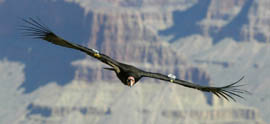Cronkite News has moved to a new home at cronkitenews.azpbs.org. Use this site to search archives from 2011 to May 2015. You can search the new site for current stories.
Conservationists: Ban on lead hunting bullets would help Arizona
PHOENIX – A new effort to get the federal government to ban lead-based ammunition used by big-game hunters is especially important for the dozens of California condors in Arizona and Utah, an environmental group contends.
Those birds and other animals can be poisoned by lead bullet fragments in piles of deer or elk entrails that hunters leave in the wilderness.
“We’ve removed lead from pretty much every product we use. The last remaining source that’s a significant problem for wildlife is ammunition,” said Jeff Miller, conservation advocate for the Tucson-based Center for Biological Diversity.
One hundred organizations in 35 states petitioned the Environmental Protection Agency this week to regulate lead in hunting ammunition. The EPA refused a similar petition that four groups filed in 2010, saying it doesn’t have the authority to regulate hunting ammunition.
In a telephone interview from San Francisco, Miller said the agency has that authority under the Toxic Substances Control Act.
A spokeswoman in the EPA’s San Francisco office referred questions to headquarters in Washington, where a call ran unanswered late Wednesday afternoon.
The U.S. Fish and Wildlife Service has banned the use of lead shot for waterfowl hunting nationally because the pellets poison birds that eat them off the bottoms of streams and lakes. In 2007, California required non-lead ammunition for hunting big game and coyotes in the California condor’s range.
The population of endangered California condors has increased from 22 in 1982 to more than 350 today due to captive breeding programs.
Since the birds were reintroduced in northern Arizona in 1996, 21 have died from lead poisoning in Arizona and Utah and many more have been treated for lead poisoning. Miller said the situation makes the condors more like zoo animals.
“They get lead poisoning and are captured, they’re fed and they’re prevented from being wild animals,” he said.
Kathy Sullivan, condor program coordinator for the Arizona Game and Fish Department, said the agency opposes the petition because lead ammunition is something states should regulate. She noted that a voluntary Game and Fish program offers coupons for free non-lead ammunition to hunters with tags for big game in condor territory and educates about the importance of removing gut piles when hunters use lead ammunition.
Over the past four years, she said, between 80 percent and 90 percent of hunters have reported using non-lead ammunition while 60 percent of those who used lead ammunition said they took steps such as removing gut piles to reduce the risk.
“Hunters and sportsmen would be more engaged if it weren’t so politicized,” Sullivan said. “We should cooperate rather than force people into actions they don’t support.”
Miller called the state’s efforts “a dramatic failure.”
“We know they’re going to get poisoned,” he said. “They get poisoned, we treat them and then we put them back out there in the same environment.”
Kim Crumbo, conservation director for the Grand Canyon Wildlands Council, said the danger posed by lead ammunition isn’t an anti-hunting issue.
“It’s a responsible hunting issue,” he said.







